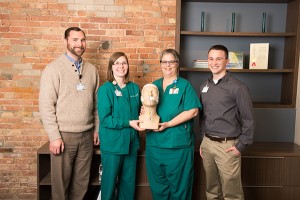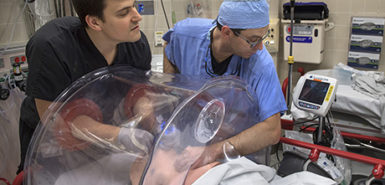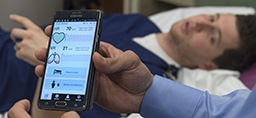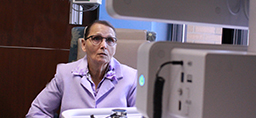
You’re confused, restrained and feel like you’re choking. There’s something in your throat. It’s a tube.
People are around you, but you find it difficult to talk or communicate. Your first instinct may be to pull the tube out. The medical term for removing a tube is “extubation.”
Nancy Wall knows from clinical experience the complications that can arise from spontaneous or unplanned extubation. As a respiratory therapist at Spectrum Health, Wall frequently treats patients who have an unpleasant response to endotracheal intubation, the process by which a tube is placed down one’s throat.
“The body reacts to the (tube) as a foreign object,” Wall said.
A foreign object, but also a crucial clinical tool, the tubes are used to move oxygen and other gasses from a ventilator to and from the lungs of patients with severe respiratory illnesses, or those undergoing surgical procedures. An estimated 15 million to 20 million intubation procedures are performed in the U.S. each year.
“A significant number of patients with an endotracheal tube will try to self-extubate, which can result in some form of trauma, including loss of airway and, in extreme cases, even death,” Wall said.
Even in not-so-extreme cases, patients often report unpleasant side effects from intubations ranging from difficulty swallowing to chest and neck pain. And unplanned extubations can lead to increased morbidity, higher costs, and higher ICU and hospital length of stay.
One recent study analyzed data from patient records from the 1950s through 2011 and estimated that there are as many as 3.6 unplanned extubations for every 100 days a patient is intubated. A number of recent studies report rates of unplanned extubation between 7 percent and 18 percent of all intubations in an intensive care setting.

In 2014, Eric Van Middendorp, a Grand Valley State University master’s degree engineering student received a grant from the Michigan Initiative for Innovation & Entrepreneurship and set about tackling the issue of patient extubations.
Spectrum Health Innovations recruited Van Middendorp to collaborate with Spectrum Health clinical staff to design a retaining block to keep the tube in place. If a patient pulls at the tube or the tube gets bumped, it won’t move.
“I’ve always had an interest in the medical field and was immediately drawn to this project,” Van Middendorp said. “My nephew performed a self-extubation, so I know how valuable a device preventing self-extubation will be for patients.”
Van Middendorp’s device, the EV Airway Innovation, uses headgear modeled after a scuba mask to hold the retaining block in place. The mask does not cause abrasions on the patient’s skin, which is especially important since clinicians advised that the tape typically used to hold the tube in place can sometimes be painful and scary for the patient.
“Once I came up with the retaining block idea, it seemed so simple,” Van Middendorp said. “Then it was only a matter of getting the design just right.”
“We know firsthand the complications involved with having an endotracheal tube,” said Chad Huizenga, a respiratory therapist at Helen DeVos Children’s Hospital, who, along with Wall and others, consulted on the design of the device. “Eric listened to our concerns and created a device that will be a huge improvement in safety and comfort for our patients.”

On March 31, Van Middendorp won the grand prize of $25,000 at the GreenLight Business Model Competition, a startup event series that brings together entrepreneurs and small business supporters from throughout Michigan.
Next steps involve selecting a manufacturer to license and further develop the prototype to seek FDA approval. Next on the competition horizon is the 2015 MWest Challenge, a student business plan competition held on April 17 designed to create cross collaboration between students in West Michigan.
 /a>
/a>
 /a>
/a>
 /a>
/a>